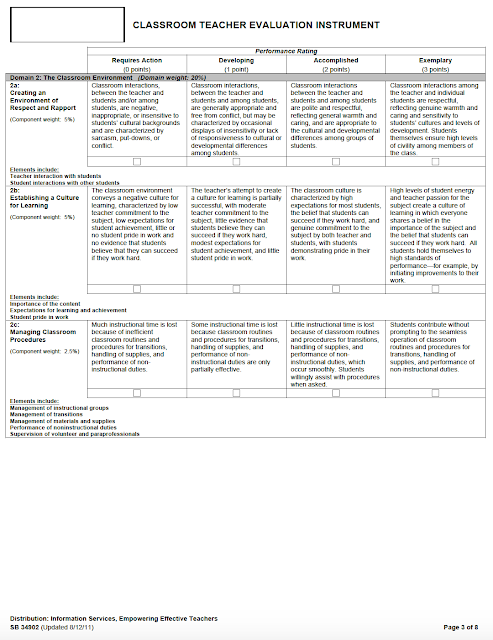Everyone in public teaching knows what it's like preparing for a formal observation. Very few teachers look forward to the hoops that they have to jump through for the process. If you read my post on Failing Teachers you will know exactly how I feel about my current evaluation system.
Evaluation rubrics are different among different districts and states. Our rubric claims to follow the Danielson model. Below you will find the 8 page rubric that we are evaluated on for a formal observation. In my district, PK-highschool teachers have the same rubric. I currently teach ELA for 2nd grade.
Let me start by saying that I am in no way a lesson plan or observation guru. I usually score pretty well, but I am human and trying to make my way through the process just like everyone else. My hope is to help another teacher out the same way teachers have helped me. Just maybe, you will find my notes and materials helpful.
When preparing for formal observations we must first choose a lesson topic to teach. We are encouraged to follow our district calendar unless we can provide data that shows our students are in need of another lesson first. Once I choose my lesson topic I use a backwards design to form a lesson plan. For this lesson, my students took a benchmark test that showed the majority needed more work with main topic of individual paragraphs. Below you will find my lesson plan. The lesson ended up lasting 1 hour and we did not complete the independent work.
When planning the lesson, there are a few points that I focus on more than others.
1. Differentiation - I want all of my students to feel successful when they are learning. I do this by differentiating my materials. In this lesson I have differentiated text and task cards.
2. Questioning - If we teach the students to ask questions throughout their learning, they will be able to guide their own learning without us. It's important to provide them with a lot of opportunity to practice questioning during the lesson.
3. Discussion - Just like questioning, students need to be able to have conversations with each other that helps them to learn. We as teachers can't be with every student, every minute. We can however teach them to work together to extend their learning.
4. Engagement- The kids need to love what you are teaching them. The text has to be engaging and hold their attention.
Of course life happened during my lesson and we had some hiccups. The largest issue was that during our winter break, the students forgot what a paragraph was. If I were doing it again, I would either review what makes a paragraph first, have the students number the paragraphs or cut the passages and have them work on one section at a time. Partner work could have gone better, but we have to work with what we have. A couple of friends were less than helpful and I heard a lot of "I don't know". This happens when we have visitors in the classroom. I improvised the lesson, pulled the class together during independent work and had a class conversation. I wanted the class to demonstrate that they 1. Understood the essential question. 2. Could answer the essential question. 3. Could provide examples from their text. I purposefully called on the students who kept saying "I don't know what to do". Each student was able to demonstrate what I needed them to. When things start to fall apart, we have to be flexible and demonstrate that the students understand. We can't just say they do. I felt much better after a good portion of the class was able to regroup and show their knowledge of the standard. I was also concerned that the students were not giving their partners the right grade from their rubric. I had them revisit the rubric and regrade themselves. This showed that the students were able to self-assess accurately and that I was aware of what was happening with the class.
Above you have read and seen my notes for the lesson as well as the lesson plan. I put together a free file with my anchor charts and differentiated task cards for you to look at. You can find that by clicking here. I hope that you have found something here that you can take back to your classroom. I would love to hear what you think, so please leave a comment below.












